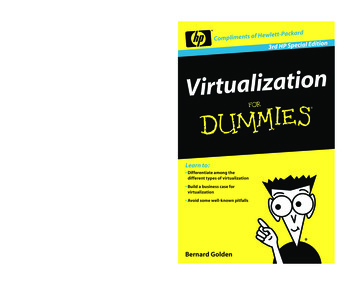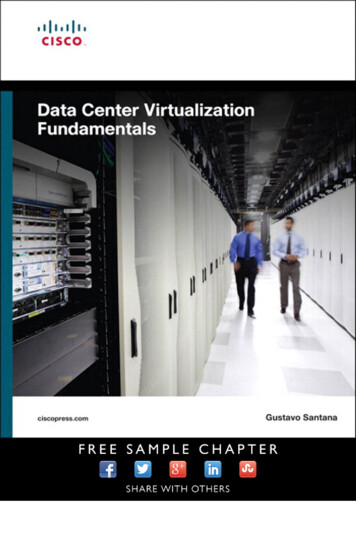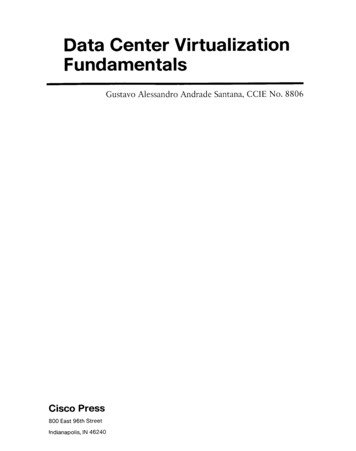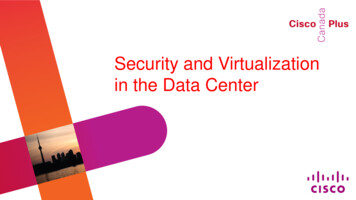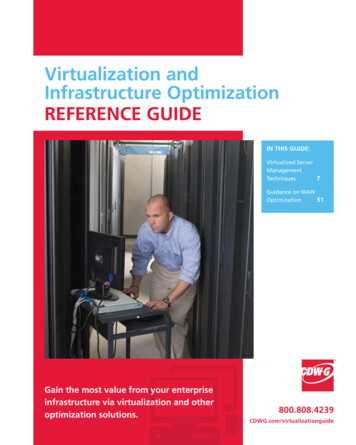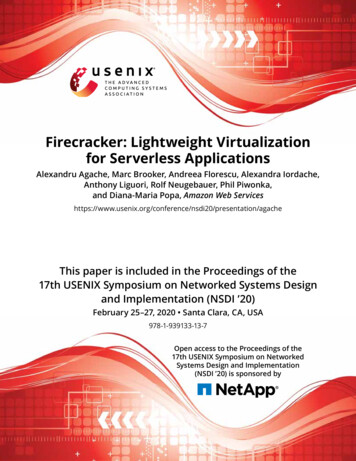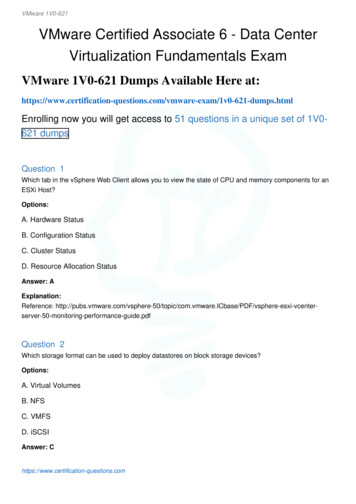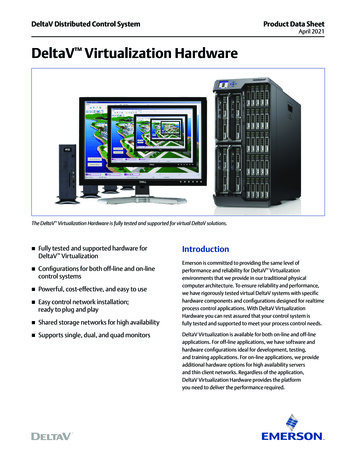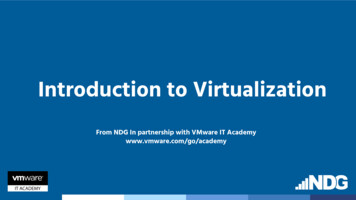
Transcription
Introduction to VirtualizationFrom NDG In partnership with VMware IT Academywww.vmware.com/go/academy
Why learn virtualization?
Modern computing is more efficient due to virtualization Virtualization can be used for mobile, personal and cloud computing You can also use virtualization in your personal life
Course Sections Covered Module 2 – Introduction to Virtualization Module 3 – The Hypervisor Module 4 – The Data Center Module 5 – The Virtual Data Center Module 6 – VMware Virtualization SolutionsContent will cover : Understand the benefits ofvirtualization Be able to describe virtualization,virtual machines and hypervisors Describe typical data centercomponents that are virtualized Become familiar with VMwaretechnology popular in industry
Why virtualization? Have you ever wished you could clone yourself? If you could, would you be more efficient? Would you do more? Virtualization enables computers to be more efficient in a similar fashion Computers that use virtualization optimize the available compute resources
What is virtualization?
Hardwareand Software Do you use a smartphone, laptop orhome computer? Smartphones, laptops or homecomputers are hardware Similar to how your brain controls youractions, software controls hardware There are different types of softwarethat control computer actions
HardwareProcessor- Also called CPU (Central Processing Unit)RAM- Random Access MemoryRead-Only Memory- Non-volatile memory that stores BIOS*BIOS is type of software responsible for turning on (booting)computerMotherboard- Printed Circuit Board (PCB) that holds processor, RAM, ROM,network and Input/Output (I/O) and other components.Chipset- Collection of microchips on motherboard that manage specificfunctions.Storage- A persistent (non-volatile) storage device such as a Hard Drive Disk orSolid State Drive
Software System software is necessary forhardware to function Operating system controls thehardware Application software tells yoursystem to execute a task youwant
Now that you are aware ofthe roles of hardware andsoftware, the concept ofvirtualization will be easier tograsp. Virtualization is the“layer” of technologythat goes between thephysical hardware of a deviceand the operating systemto create one or more copiesof the device.
What is a VM? Virtualization creates virtual hardwareby cloning physical hardware The hypervisor uses virtual hardware tocreate a virtual machine (VM) A VM is a set of files With a hypervisor and VMs, onecomputer can run multiple OSsimultaneously
The Hypervisor
What is a Hypervisor? Software installed on top ofhardware that createdvirtualization layer Hosts VMs Type 1 Hypervisor – Bare metalhypervisor (VMware ESXi) Type 2 Hypervisor – Hostedhypervisor (VMwareWorkstation)
Virtual Machine Files VMs can be exported and moved to other hosts Files are created by the hypervisor and stored in a directory Example VM files:File TypeFile NameDescriptionLog File vmname .logKeeps a log of VM activityDisk File vmname .vmdkStores content of VM’s disk driveSnapshot Files vmname .vmsd and vmname .vmsnStores information about VMsnapshots (saved VM state)Configuration File vmname .vmxStores information about VMname, BIOS, guest OS, andmemory
What is a snapshot? Working on a VM and need to save progress or state Snapshots are saved as files in the VM folder ( vmname .vmx) What is saved by a snapshot?- State of VM disks- Contents of VM memory- VM settings
The Data Center
What is a Data Center? Hardware infrastructure that supportsvirtualization Focus is on processing large amounts ofdata What are the three main components?- Compute- Storage- Networks
Compute Systems Hardware and operating system software that runs applications Difference between a PC and a server- PCs have user-friendly interface while servers focus on running programs Types of servers:- Tower- Blade server- Rack-mounted server What is the architecture of a server?
Networks Transfer data across the data center so devices can communicate What type of hardware is used for networking?
Storage Data center storage should have two features: availability and redundancy
Storage - RAID Redundant Array of Independent Disks Hard drives linked together to create a large volume of redundant storage What are the three methods of writing to RAID?- Mirroring- Striping- Parity What do the RAID numbers mean (i.e., 0, 1, 5)?
Storage - Block vs. File Level Block-Level Storage – Data is written to and accessed from storage volumes(blocks) File-Level Storage – Data is written to disks but accessed from default filesystem
Storage – Types of Data Center Storage DAS – Storage device is directly attached to a server (block-level) NAS – Storage device is attached to a network, servers on the network canaccess device (file-level) SAN – Clustered storage devices on their own network that servers canconnect to (block-level)
ProtocolSCSI (Internet Small Computer System InterfaceApplicationMedium-sized blade servers, Enterprise servers,DASCommon Data Center StorageProtocolsEnterprise servers, SANFC (Fiber Channel)FCoE (Fiber Channel over Ethernet)Enterprise servers, SANiSCSI (Internet Small Computer System Interface)Enterprise servers, NAS
Storage Provisioning Thick provisioning: Diskspace is strategically preallocated to a server, or aVM. This means that thelogical space provided bypartitioning is equal to theamount of actual physicalspace set aside on thephysical disk.
Virtual Data Center
Benefits of a Virtual Data Center Data centers use a lot of hardware and virtualization makes hardware moreefficient Increased computing resources results in higher availability of applications Less labor needed to monitor data center (administrator can monitor from deskusing a program) Software-defined data center (SDDC): Hypervisor pools physical data centerresources into a virtual data center
What is vSphere? Suite of virtualization technology designed for larger enterprise data centermanagement vSphere virtualization tools include:- ESXi: Type 1 Hypervisor- vCenter: Management software (installed on management server)vSphere Client: Program that controls host servers and VMs
vSphere
What is ESXi? ESXi is VMware’s Type 1hypervisor software installeddirectly on the physical serverand creates the virtual layer Components of ESXi:- Unix Microkernel- VMware Kernel(VMkernel)
vCenter and vSphere Client vCenter: Software installed on adedicated server to manage ESXi serversand other components of a virtualizeddata center vSphere Client: Program with agraphical user interface (GUI) that allowsdata center administrators to connect tovCenter and ESXi remotely
Server Virtualization Results in increased efficiency of data center servers because multiple VMscan be hosted on one server Computing resources can be distributed to customers using less hardware
Storage Virtualization Storage capacity is pooled and distributedto the VMs- Physical storage devices arepartitioned into logical storage(LUNs)- LUNs are used to create a datastore How do VMs access data center storage?- VMs are stored as VMDK (.vmdk)files on datastore- VM configuration files (VM settings)are stored as VMX (.vmx) files
Network Virtualization Physical components that make up the physicalnetwork are virtualized to create a virtual network What is a vSwitch?- Virtual switch that virtual devices canconnect to in order to communicatewith each other What is a vLAN?- Virtual Local Area Network that issegmented into groups of ports isolatedfrom one another, creating differentnetwork segments
Types of Virtual Networks Bridged Network: The host server and the VM areconnected to the same network, and the hostshares its IP address with the VM NAT: VMs use an IP translated from the host’s IP(using NAT device) and communicate on a privatenetwork set up on the host computer Host-only Network: VMs use a private networkbut do not have translated IP addresses toconnect to external network, therefore can onlycommunicate to other VMs on the isolated hostnetwork
Application and Desktop Virtualization Why use virtualized applications?- Some applications have specific system requirements- VMware Thinapp creates a packaged virtual app, that contains theprogram and system requirements, and delivers it to the end-user What is desktop virtualization?- Designed to solve computing resource issues faced by the mobileworkforce (workers that need computing without the hardware)- VMware Horizon takes the resources needed to create a desktopenvironment from data centers and delivers it to the end-user’s device
The Cloud Cloud computing is the delivery ofshared computing resources(software and/or data) on-demandthrough the internet
Convergence Convergence: Moving from a traditional hardware-based server model to avirtual data center Two strategies:- Containment: Not deploying any existing applications for customers onvirtual servers. Maintain applications running on the hardware-based datacenter.- Consolidation: Moving applications that are running in the oldhardware-based data center model using VMware P2V technology
VMware Solutions
vMotion Move running virtual machines from one ESXi host to another ESXi host withoutservice interruption (live migration) Increases availability of data and computing resources
Storage vMotion Move the disks and configuration files of a running virtual machine from onedatastore to another datastore without service interruption Increases availability of storage
High Availability (HA) Pools servers (hosts) and the VMs that reside on them in a cluster so that in theevent of a failure, the virtual machines on a failed host are restarted on alternatehosts
Distributed Resource Scheduler (DRS) What problem does DRS solve? HA clusters need to be monitored andmanaged. DRS implements a sharedmanagement interface so that thecluster’s resources can be monitoredand managed vSphere Storage Distributed ResourceScheduler provides the same solutionfor storage clusters
Fault Tolerance (FT) A secondary copy of that virtualmachine and its files is created onanother ESXi host and datastore Using FT, the transfer to a differentserver is seamless and will not benoticeable to the end-user
Replication vSphere Replication makes copies ofVMs in a different physical location,useful for data protection and disasterrecovery Works with vSphere Client to allowadmins to monitor
VMware VSAN (Virtual Storage AreaNetwork) virtualizes existing storage indata center servers Creates a hyper-converged infrastructure;integrated virtualized data centercomponents from one vendor (i.e.,VMware) (Do you recall what a convergedinfrastructure is?) Interacts with vSphere to create one layerof virtualization software, which ismanaged by the vCenter managementlayer
NSX Suite of virtualization solutions for datacenter networking VMware NSX creates a ‘softwarenetwork’ on top of the physical networkthat can be divided up into many virtualnetworks Virtual networking components included
Creates a hyper-converged infrastructure; integrated virtualized data center components from one vendor (i.e., VMware) (Do you recall what a converged infrastructure is?) Interacts with vSphere to create one layer of virtualization software, which is managed by the vCenter management layer Suite of virtualization solutions for data center networking VMware NSX creates a .
